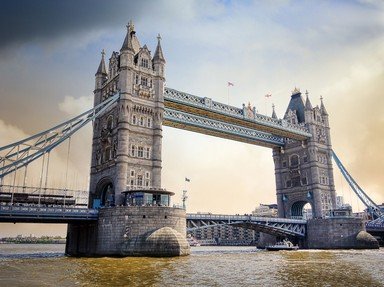Quiz Answer Key and Fun Facts
1. The river pictured here runs through both Liverpool and Manchester, and empties into Liverpool Bay. Overseen by a pair of birds at Pier Head, it carries passengers back and forth and was a proud maritime industrial centre for many years. Which river is this? (Gerry and the Pacemakers might know.)
2. This river is part of the Thames, and runs through Oxford. It is a popular spot for the rowers of Oxford University, and for anglers due to its freshwater fish population. Which Egyptian goddess shares a name with this 'silver girl'?
3. This river is one of the rivers in this quiz that flows through both England and Wales; the picture here was taken in Chester, an English city on the Welsh border. Not to be confused with a river of the same name in Aberdeenshire, which river is this?
4. Three rivers in the UK carry this name, but the one in this picture is one of the Anglo-Welsh rivers in this quiz, and forms a large part of the border between England and Wales. If I mention the words 'Hay' and 'Ross', can you guess which river is shown here?
5. Way down in southwest England, under the bridge pictured here, lies a river that forms most of the border between the counties of Cornwall and Devon. It is designated as both an Area of Outstanding Natural Beauty and a Site of Specific Scientific Interest. Which river is this? (The Biblical King David might know.)
6. There are four rivers in England with 'Ouse' in their names, the Great Ouse, the Little Ouse, and the two other Rivers Ouse. One River Ouse is in Yorkshire, while the other one is in Sussex. Which of the two Ouses is the longer one?
7. Pictured here is the stunning view of the River Tyne, a river in the north-east of England. For centuries, it was a key transportation route for coal. With which city - home of Ant & Dec, the Angel of the North and a flock of 'magpies' - is it most associated?
8. The River Ribble, pictured here, runs through two counties. One of them is North Yorkshire, but which county is the other one?
9. There are two rivers in England called the Esk, one in North Yorkshire and one in Cumbria. The Yorkshire Esk flows directly into the North Sea, rather than via the Humber Estuary or the River Tees. At which town, popular with goths and vampire fans, does it empty into the sea?
10. On the left of this photo is the City Ground, home of Nottingham Forest FC. Both Forest and their local rivals, Notts County, play at grounds on either side of Nottingham's biggest river. Can you name the river?
Source: Author
Kankurette
This quiz was reviewed by FunTrivia editor
agony before going online.
Any errors found in FunTrivia content are routinely corrected through our feedback system.
